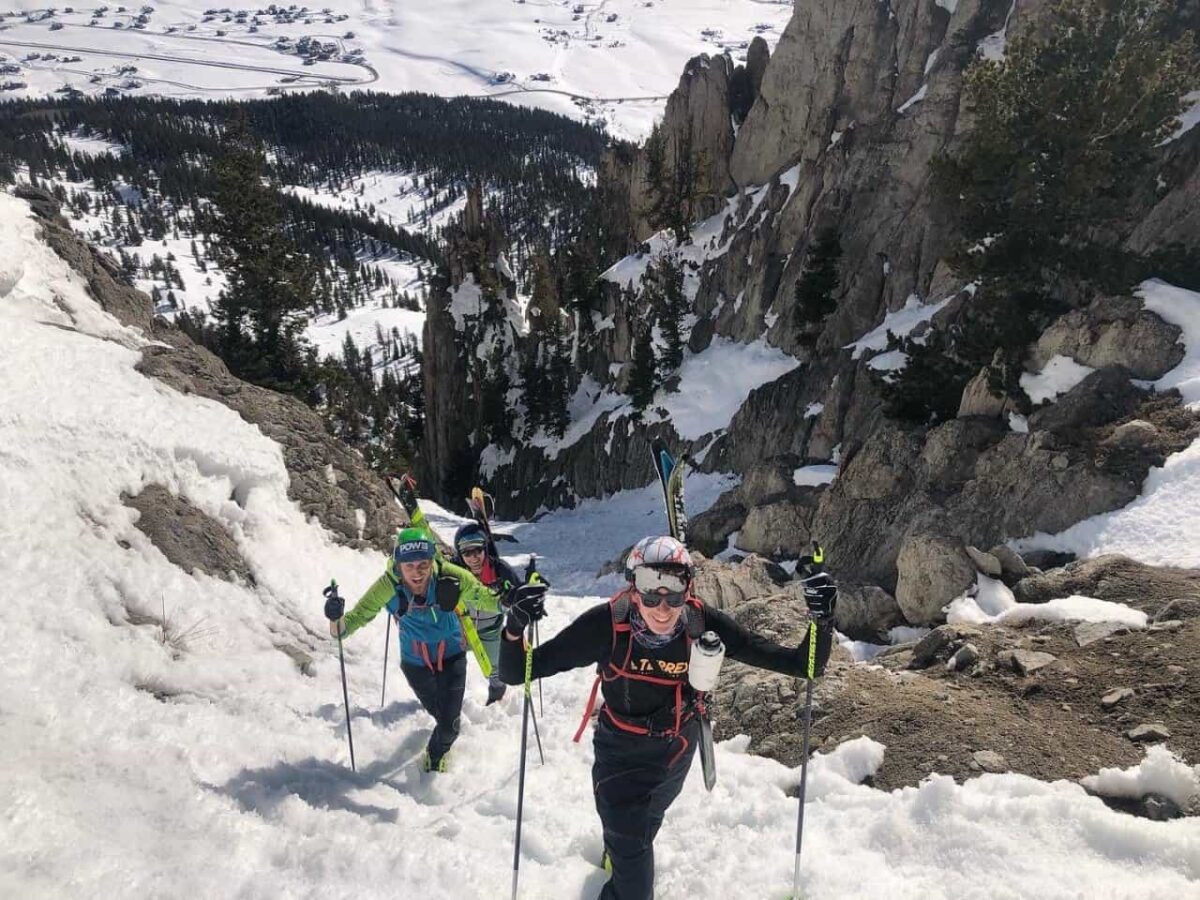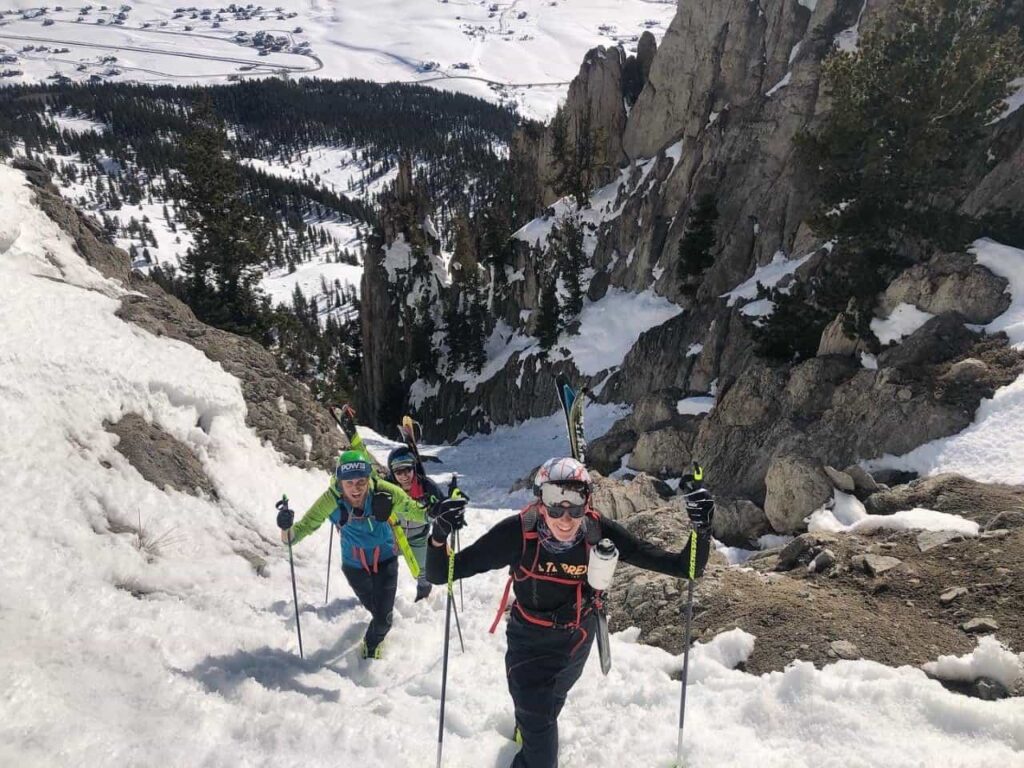
“In a nutshell, it’s competitive backcountry skiing,” says Sam Burke, a rising sophomore from Silverthorne, Colorado studying Exercise and Sports Science (ESS). “Competitors place climbing skins on the bottom of specially-designed, ultralight skis, and run up the mountain, and then rip their skins, transition their equipment, and ski down—[either] for time or for place.”
Ski mountaineering, essentially high altitude trail running but on skis, or, from a different vantage, nordic skiing with the introduction of some serious elevation and terrain, is a niche but growing sport, one of seven offerings within Western’s unique Mountain Sports program.
The sport of skimo
Ski mountaineering, or skimo, as it is frequently known, arose out of a culture of winter mountain travel without the aid of chairlifts or other forms of motorized transport, predominantly present within the mountains of Europe.
The sport has gained more traction in the United States within the last several decades, particularly in and around mountain towns like Breckenridge, Crested Butte, Vail, and Aspen.
Cam Smith is the team’s coach and a recent Western alum. He began his skimo journey when he was a freshman back in 2014, coming to Western from Illinois—and a running background. At that time, both the Mountain Sports program and the Ski Mountaineering team were just a couple years old.
The skimo team began, in essence, as a training program for a few brave athletes looking to ski the Grand Traverse —with a few other smaller races thrown in as tuneups. When Smith himself graduated after falling in love with the sport at Western, he became the team’s first coach.
He is quick to note the benefits of ski mountaineering, and other mountain sports program, on student recruitment, retention, and academic performance.
“Western has a pretty unique program…we’re pretty much the only place with a trail running team and a ski mountaineering team,” says skimo athlete Sam Burke.
Burke notes that a number of other schools on the Front Range boast students who are fast runners and skiers, but Western is unique in its unified team aspect—made possible by the overarching Mountain Sports program and the school’s proximity to mountain terrain.
“I think that Mountain Sports is something that’s really special and something that Western should be really proud about,” says Burke. “I can honestly say that skimo has changed my life—the skimo community is just so positive.”
The sport of ski mountaineering offers three major disciplines: course-based races, known as “individual”, verticals, and sprint. Then there are the team races—like the Grand Traverse, which are similar to individual races but longer and often more hazardous—thus the required team aspect.
Sprint events are, as you would expect, fast and furious: skiers go as hard as they can for several minutes over a course that features an uphill portion, a bootpack (hiking with skis on your back), and a downhill through the finishing gates. In sprints, there are often multiple rounds of competition to determine the final set of winners.
The vertical discipline is also fairly self-explanatory–skiers will climb an incline as quickly as possible, with no transitions, an event that places a heavy emphasis on raw cardiovascular capability.
Finally, there is the individual discipline, where courses can differ substantially. In nearly all cases, courses will offer numerous climbs and descents, including various transitions (which come with their own set of rules), and several bootpacking stints.
The U.S. Ski Mountaineering Association (USSMA) and the International Ski Mountaineering Federation (ISMF) set parameters for the different disciplines, but host mountains have the flexibility to make their courses unique, and racers must plan accordingly.
“If you run a 10k at sea level on the track you can do that pretty much anywhere in the country, and so everyone has a time that is comparable to anyone else,” says Kieran Nay, a member of Western’s skimo team.
“Whereas in any kind of mountain sport—if you want a time that’s comparable to anyone else, you have to run the same race, and you probably have to do it in similar conditions, and there’s all these other caveats [with] weather and terrain.”
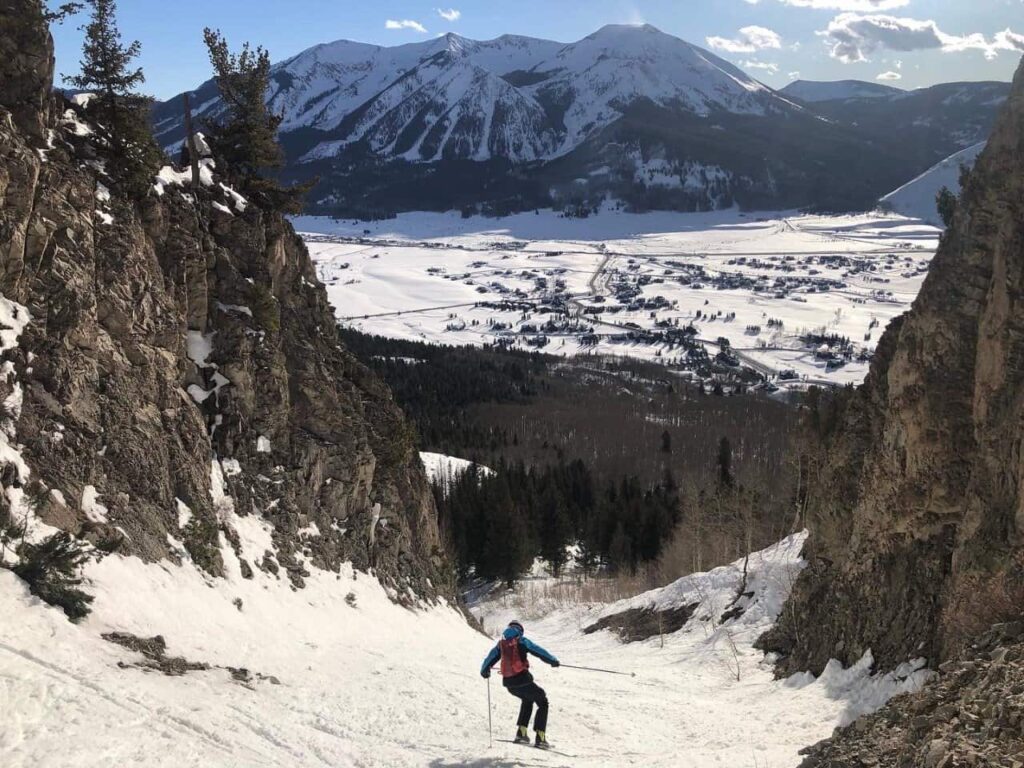
Introducing Western’s team
Western’s 2021-22 team included four members, a strong, close-knit group that included Maggie Ammons, Kieran Nay, Sam Burke, Jack Breezly, along with coach Cam Smith. “We all really care about the sport,” adds Ammons.
With the pandemic, the team unfortunately lost some athletes—including those who decided to pursue other ventures, like snowboarding, skiing or other mountain-based sports. The sport’s grueling difficulty can also make it difficult to retain athletes for the long haul.
Kieran Nay is a rising fifth year student in Western’s 3+2 High Altitude Exercise Physiology (HAEP) program, having just graduated with his undergraduate degree. Nay came to ski mountaineering from a background in Nordic and alpine skiing, and from a history as a runner that originally drew him to Western to run for the Mountaineer’s Cross Cross team.
Once he was a Mountaineer, Nay saw what some of his friends were doing on the Mountain Sports side, and made the decision to leave the team at the end of his freshman year, opting for summers filled with trail running, and winters dedicated to ski mountaineering. “A lot of it is just a way to train in the mountains…I don’t want the snow to be the end of my mountain [experiences] for the year,” says Nay.
Burke is planning to pursue the university’s 3+2 Master’s degree option in HAEP himself. He’s interested in examining the performance of Skimo athletes in relation to their altitude training.
“I’m from Summit, so I was skiing before I could walk in my driveway,” he notes. In middle school, Burke dove into cross country and track, growing more competitive and making a foray into trail running.
“I started training with a coach up in Summit for trail running in the summers, and it turned out that he was the U.S. National Team coach for skimo,” says Burke, who was quickly recruited into the sport for his sophomore year, and qualified for the U.S. National Team in his age bracket the following spring.
Maggie Ammons, a Western alumna who just received her Master’s degree in High Exercise Exercise Physiology, was the team’s lone female member in 2021-22. For Ammons, ski mountaineering was a shared passion with her now-husband, and something she’s done for six years. “It’s uber exercise nerds who run around in spandex together,” she says with a laugh.
Ammons and her husband like the grand courses—longer events with the required team entry. “It’s usually something like 27 miles and 12,000 vertical feet…the really Type 2 fun adventure sort of skimo races,” she says.
These races often start at midnight for a variety of safety concerns—avoiding afternoon storms, for example—and the winners will typically be looking to finish around daybreak, in the five to seven hour range.
In one recent example, Western’s own Coach Smith won the Grand Traverse race back on April 3 with a time of 6:15:13.4, leading the field of 192 entrants.
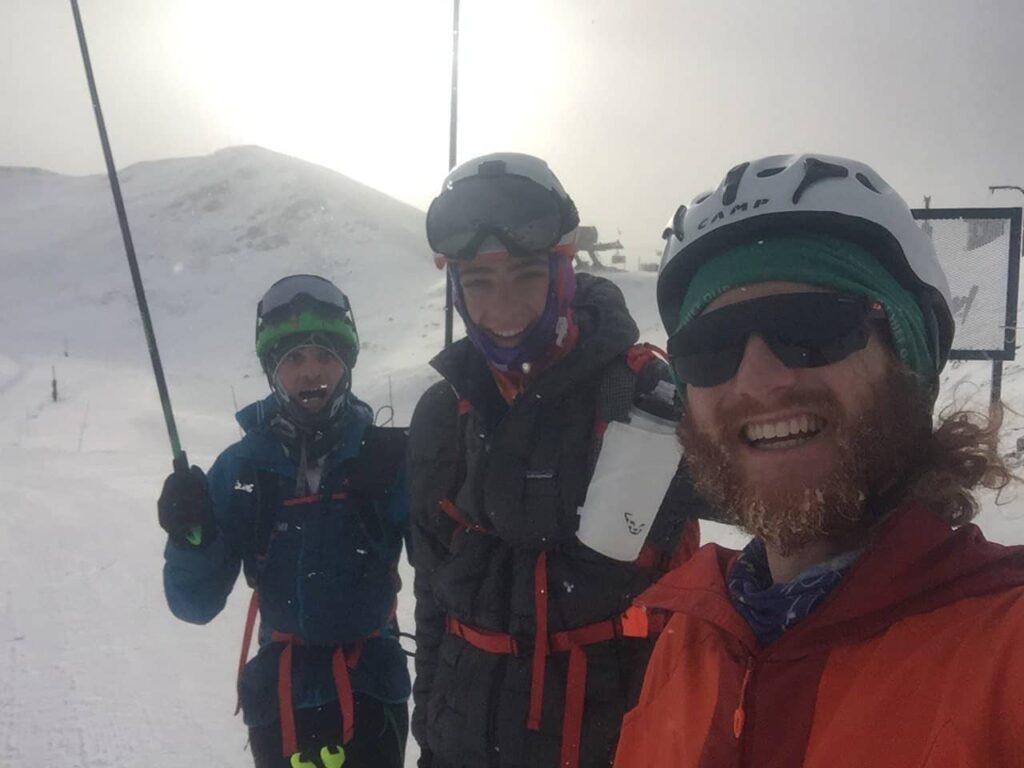
Navigating the sport’s racing landscape
In terms of the skimo season, Coach Smith says there is usually some terrain to ski by mid November, but the practice season typically begins in earnest after Thanksgiving Break, and races will begin in December.
This year, the team kicked off the racing season with a bang at the U.S. National Team qualifiers in Arapahoe Basin back in December 2021.
Coach Smith won those qualifiers in both the one and a half mile vertical (22:23.3) and individual disciplines—covering eight miles in 1:36:40.8. The wins afforded him the opportunity to compete at the World Championships in Europe. On Jan. 14, Smith became the first North American man to podium at a World Cup event, taking third in the vertical discipline in Andorra.
Nay placed 10th in the vertical discipline, which saw skiers cover 1.5 miles with a hefty 1,500 feet of elevation, with a time of 25.55.3.
Burke and Breezley took second and fourth, respectively, in both the individual and vertical events within the U20 division at A-Basin.
Later in the season, Vail hosted skimo’s National Championships on Feb. 25. Breezley finished second in the men’s U20 individual category with a time of 01:35:18.1, while Smith took second in the overall—10 miles and 4,500 feet of elevation gain— and first in the sprint discipline.
Members of the team also went to Aspen’s Power of Four in early March, a notoriously steep race, clocking in at 24 miles and 10,000 feet of elevation gain.
And then there was the Grand Traverse, a longer (40 miles), more gradual course (6,800 feet of elevation gain is what passes for moderate in skimo) that took place this April. The race runs from Crested Butte to Aspen, and favors strong skate skiers who can cover flat ground quickly.
Nay notes that there are not nearly as many skimo races as there are ultramarathons, for instance, a fact which tends to centralize the skimo community at a handful of power races. Every race has a particular character which can favor different athletes’ strengths, or expose their weaknesses.
Breezley and Burke, the team’s two freshmen—now rising sophomores, competed at Utah’s Wasatch Powderkeg race, and went 1-2 in the sprint and individual disciplines for their age bracket.
They rounded out their season’s with strong performances during a late March trip to Kicking Horse in British Columbia for the Steep Dreams Ski Mountaineering Festival, which served as the sport’s North American Championships.
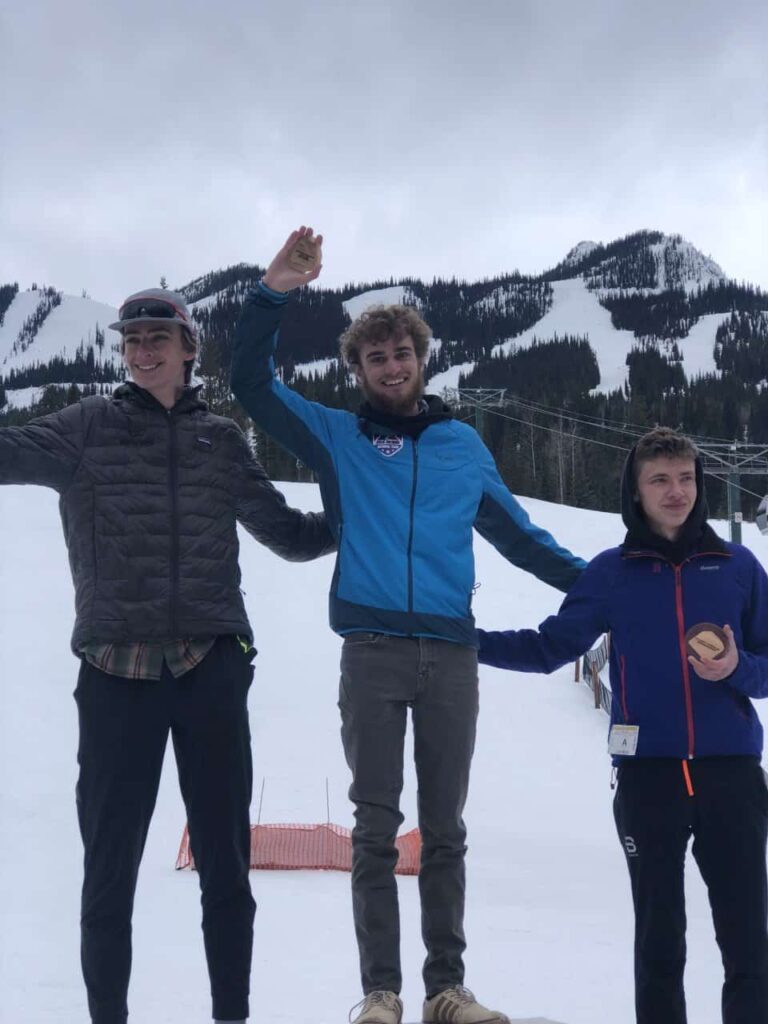
Mastering the technique
For many ski mountaineering athletes, there is a natural training synergy with trail running, and with other cardio-intensive summer sports like mountain biking. Western’s skimo team is no exception.
But when it comes time for the specific, winterized training, Western’s team conducts much of their training up at Crested Butte Mountain Resort (CBMR), skinning up the mountain during the resort’s off hours, making repeated laps to augment their gym and off-season training.
Trimming times in ski mountaineering involves a blend of technique work, increasing efficiency while also utilizing constant, relentless conditioning to boost an athlete’s aerobic capacity. Burke notes that the sprint discipline is heavy on the technical focus, since such a large share of the event’s time is spent in the transitional phases.
“That’s what I love about skimo, it’s not just putting your head down and grinding through a race. It does take a lot of technical skill, finesse, and knowledge to be able to transition your equipment, to do kick turns, to avoid blowing turns on really steep terrain, managing different snow types, and descending on what are basically skis with edges—that’s what appeals to me,” he says.
“You look at the European guys that are training at really specific altitudes, and they perform miles above anyone in the U.S…they can train at really high work loads and do really specific training to meet the needs of skimo,” says Burke.
He cites his family’s Silverhorne home at 9,300 ft. as ideal for training oxygen delivery, but less so for the muscular performance that impacts speed. Contrast this to European skiers, he notes, who are able to access a broad range of altitudes more easily, enabling them to engage in more complete training.
Having completed his third season, Nay is working hard to match his aerobic capabilities and become equally proficient in the technical aspect of skimo, “Your technique is really important—getting glide on the skis, and managing gear in terms of [your] layers,” he says, noting a couple critical questions for skimo athletes: ‘“Where am I going to store my skins? How fast can I transition?”
To demonstrate the importance of the sport’s technicality, Nay talks about his comparative performance to Coach Smith, who is consistently one of a top handful of skimo athletes in North America, and a sponsored athlete in both trail running and skimo with Dynafit.
“Him and I will run races together, and he will beat me, but not by much. And then we’ll ski races together and he will blow me out of the water, because his technical skills are so, so, so good,” relays Nay, who recently signed a professional contract with Salomon to become a sponsored trail runner himself.
Not only can the sport require years of dedicated practice to perfect, it’s also physically grueling. “It’s a genuinely hard sport. I think some people like the idea of it, but then they try skinning three days a week, and they’re like ‘Ow!’ A normal person will [only] skin up CBMR once, and we’re doing it multiple times in one practice,” adds Ammons.
Before the national qualifiers in December, the team built a mini course area and ran through the transitions like they were in the race—mocking the vertical gains, the downhills, and the bootpacks. “We practiced [the course] for five or six minutes doing every transition, in order, that we would do in the race—just to have it in your head,” says Nay.
In some races, competitors may be required to carry more advanced mountaineering gear like ice axes, an indication that the race includes more technical, and potentially dangerous, alpine elements—really putting the “mountaineering” in ski mountaineering.
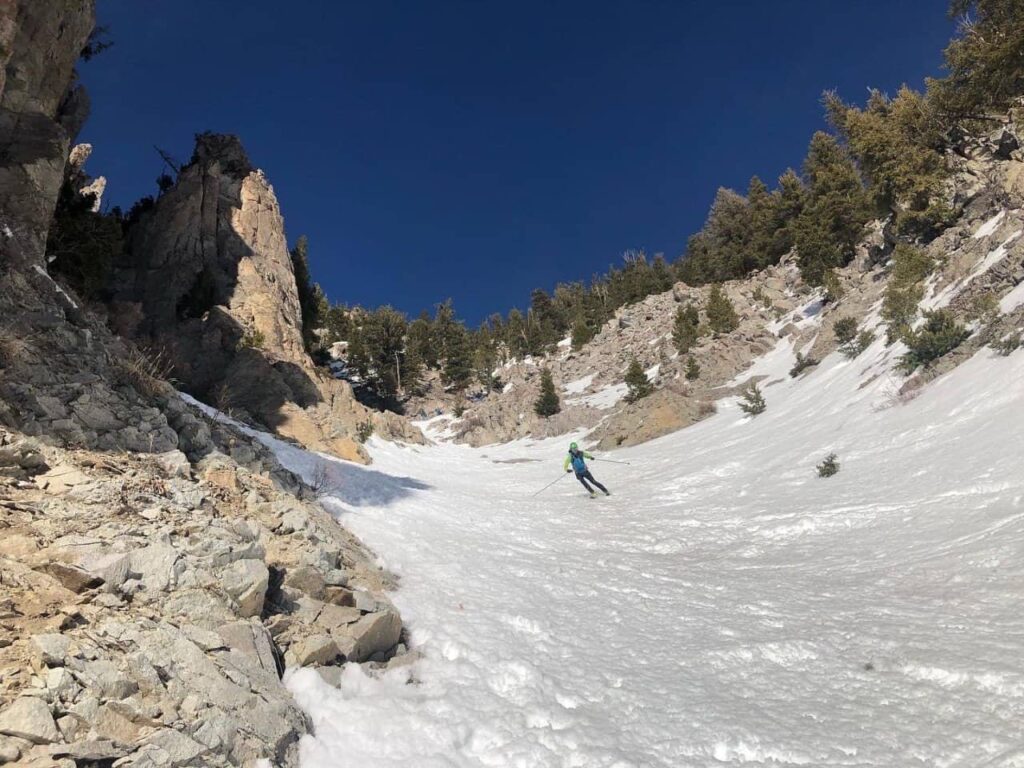
The sport’s charm
For Smith, skimo was largely a vessel for wintertime travel within the valley, a way to make the Gunnison Valley larger, more accessible year-round. “I think without that mode of travel, the valley becomes really small to a lot of people in the wintertime,” he adds.
On Ammons’ part, ski mountaineering is simply an outlet for a treasured pastime. “I genuinely love to ski, and this is one of the ways that I can keep skiing, especially as a full-time student. I can’t necessarily afford an Epic Pass or an Icon Pass, so I just uphill [ski] almost exclusively now…part of what gets me going day after day is that it feels so good. It’s genuinely so much fun.”
She adds that skimo instills hard-earned lessons upon its practitioners. “You learn a lot about mental toughness– truly you’re learning how to function during adversity. You’re [also] learning how to be gentle with yourself when things are really really difficult, which I feel like are [both] essential life skills.”
Ammons sees ski mountaineering, in all its gruelingness, as a practice in mindfulness, repeatedly asking yourself to do something you know is quite difficult. “Some people call it the ‘pain cave,’” she adds with a smile.
For Nay, he prefers to think beyond the concept of “motivation” in his training when he considers skimo. “I think motivation is a pretty transient thing…with any endurance sport—any one session, any one week, any one season— doesn’t really matter. What matters is [that] you do it day in and day out,” he says.
“Motivation waxes and wanes with whatever else is going on in your life, so I think that having a passion for it, and having it be something that you love to do [is key],” continues Nay. “It’s the best thing I do all day, is go out and train…I’ve never regretted seeing the sun rise over the mountains.”
Of course, Nay recognizes that there are hard days where he has to force himself to rise out of bed early to get a training session in up at CBMR before the slopes officially open, but he also recognizes that the ability to partake in skimo is a privilege.
“There’s huge barriers of entry to all mountain sports…to have it be a part of my daily life, and not a vacation or an expedition—just have it be like a normal Tuesday, is super cool.”
For Smith, and for the team’s members, the competitions provide a milestone for their training efforts, but it’s the training runs and touring they do as a unit that really stand out. “This year, we went up and skied one of the southwest-facing slopes on CBMR, just taking advantage of the great snow we had in January and February after the giant storm,” says Smith.
“[I got] to see them click into their skis and ski down this super inspiring terrain, then we get to the bottom and high-five…to have that be a part of their day is just such a unique thing to the school that they go to and the place that they live.”
Growing skimo
Internationally, Italy is dominant in ski mountaineering, and Burke notes that Switzerland’s corps of youth athletes is excellent. The French round out a trio of European nations with ready access to training in the Alps and Pyrenees mountains that boast strong national programs.
In Europe, skimo also simply receives a lot more attention as part of the national and sporting culture, and has for a long time. “In Europe, they televise it—you’ll see ads for it between news segments…whereas over here it’s like a group of 50 us between Crested Butte, Aspen, a couple in Montana, and a few people in Utah,” Nay says, with only a trace of exaggeration.
But there are also the obvious barriers to skimo, including the quite expensive gear. Other barriers include the need for ready access to mountainous, and preferably variable, terrain, along with a significant learning curve and sheer difficulty
There are also the safety concerns—skimo athletes carry avalanche kits and other safety gear for good reason. Nay adds that another factor which may influence skimo participation is that many mountain communities in the U.S. are struggling with high living costs, yet another factor which may discourage the development of younger skimo athletes.
The United States, however, is catching up in the world of skimo, as evidenced by athletes like Western’s Smith and Grace Staberg, a skier from Silverthorne who competes in the U23 category and has picked up several world cup wins. “In the future, the U.S. has the chance to become more competitive,” says Burke.
Currently, most of the U.S. ski mountaineering athletes hail from a handful of Western states: Colorado leads the way—and Summit County alone fields a fair share of competitive skiers, but Utah and Montana also offer competitive athletes. “What it boils down to is just access to training in the mountains,” notes Burke.
From Western’s vantage, Coach Smith is hopeful that the sport’s growing popularity in regional high schools will boost Western’s skimo team numbers. “We’re really still the only competitive and well-structured collegiate team in the country,” he adds.
Ammons adds that the sport is attracting more females, an effort led by Kate Zander, Nikki LaRochelle, and Grace Staberg, who are all based out of Summit County. “They sort of cornered the competitive market, but also helped grow the sport in a major way for women. It’s pretty cool.”
As skimo continues to grow, Ammons is on the lookout for any way she can become involved and support the sport, whether it’s working with the USSMA, serving in a coaching role, or acting as a referee capacity, which largely involves watching the athlete’s transitions to ensure they comply with the regulations, and that they are carrying the required gear. “I really value the [skimo] community, I feel like it’s so genuine and welcoming,” she adds.
Ski mountaineer’s national and international profile will only continue to expand in 2026, when the sport will be featured at the Winter Olympics in Milan Cortina, Italy, providing a concrete training goal for Western’s athletes, and ambitious skimo athletes worldwide.
“I think you’re going to see it really explode in the U.S. a bit more—and it’s cool to already be in it, and be young in it—and have the gear and a place to train,” says Nay. “ I think it has the potential to be a fully professional sport here, like it is in Europe.”
For those looking to get more involved with the sport, Ammons encourages readers to check out the U.S. Ski Mountaineer Association.
Ammons was a ski instructor for a couple years, and is open to people contacting her to learn more about the sport, or just to find a skinning buddy. She can be reached at Laura.Ammons@western.edu
If you are interested in joining Western’s Skimo team, you can check out their official page on Western’s website.

